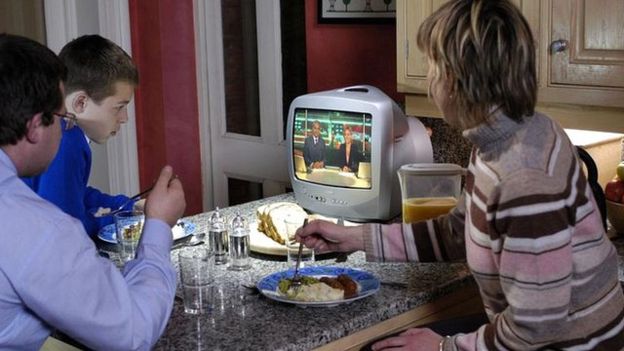The end of watching television as a family

- Del salón al bolsillo: el punto de inflexión
- Maratones, algoritmo y el fin del horario
- ¿Qué perdimos y qué ganamos?
- Guía práctica para recuperar el visionado en común
- Herramientas y configuración útil
- Impacto social: burbujas y conversación pública
- Preguntas frecuentes (respuestas rápidas)
- Lecturas relacionadas en el sitio
- Fuentes y recursos externos
Sería difícil exagerar la influencia que la televisión tuvo durante décadas en la vida familiar: reunía a todos frente a una misma pantalla, en un horario fijo y con conversación asegurada durante la cena del día siguiente. Hoy, sin embargo, esa experiencia compartida se diluye entre móviles, tablets y plataformas bajo demanda. En este artículo repasamos por qué cambió el hábito, qué implica para los hogares y cómo recuperar momentos de visionado en común sin renunciar a la flexibilidad del streaming.

Incluso si odiabas el programa, igual lo veías porque era lo que había. Ese televisor del salón marcaba un ritmo común y, con él, un tejido social: chistes compartidos, debates sobre lo que “dio anoche” y una referencia cultural que unía a barrios enteros. Ese mundo se está transformando rápidamente.
Del salón al bolsillo: el punto de inflexión
Los estudios recientes sobre consumo infantil y adolescente evidencian una mudanza del televisor fijo hacia pantallas personales: portátiles, smartphones y tablets. Por primera vez, los menores de 5 a 16 años ven más vídeo en dispositivos propios que en la TV del salón. Eso convierte el acto de mirar en algo privado, con auriculares y a demanda, y reduce la fricción —y también la conversación— con el resto de la familia.

Maratones, algoritmo y el fin del horario
El tiempo frente a la pantalla no cayó; cambió de forma. The binge-watching (ver varios episodios seguidos) eleva la permanencia en una sola serie durante horas. Ya casi nadie espera a “que empiece” a las 22:00: el prime time vive en cada bolsillo. Los algoritmos recomiendan y refuerzan gustos, lo que disminuye la exposición a contenidos que no elegiríamos, empobreciendo la discusión en casa y la cultura común.

¿Qué perdimos y qué ganamos?
- Perdimos conversación espontánea, negociación de contenidos y esa mezcla intergeneracional que exponía a niños y adultos a formatos fuera de su zona de confort.
- Ganamos control parental granular, accesibilidad (subtítulos, idiomas, pausa), menos dependencia de la parrilla y una oferta prácticamente infinita.
El reto es conservar lo compartido sin renunciar a lo personalizado. Es posible si se diseña un pequeño “acuerdo familiar de pantallas”.
Guía práctica para recuperar el visionado en común
- Agenda una cita semanal (30–90 min). Mejor corta y constante que maratones esporádicos. Un domingo de película o un miércoles de docu-serie.
- Rota quién elige. Semana a semana, cada miembro propone el contenido. Así aparecen géneros nuevos para todos.
- Regla de dispositivos: cuando hay sesión familiar, móviles fuera o en modo no molestar.
- Hablen del contenido cinco minutos: qué gustó, qué no y por qué. La TV vuelve a ser excusa para conversar.
- Listas compartidas en la plataforma de turno (Netflix, Disney+, YouTube). Añadan pendientes y voten.
- Activa perfiles y controles para edades. Evitas microbatallas y contenidos inadecuados.
Herramientas y configuración útil
- Perfiles por edad y bloqueo por PIN en cada app de streaming.
- Temporizadores en Smart TV y móviles para limitar sesiones nocturnas.
- Listas de seguimiento compartidas para decidir rápido qué ver.
- Subtítulos y audio descriptivo: inclusivos y favorecen comprensión en familia.
Impacto social: burbujas y conversación pública
The televisión común era también plaza pública: todos comentaban el mismo estreno. Hoy la conversación se fragmenta entre microcomunidades. No es malo por sí mismo —permite nichos riquísimos—, pero conviene crear espacios deliberados donde los hogares compartan something más allá de la elección individual.

Preguntas frecuentes (respuestas rápidas)
¿Ver en el móvil es peor?
Depende del contenido y la postura. Para películas y deportes, la pantalla grande mejora la experiencia y reduce distracciones.
¿El binge-watching hace daño?
Maratones ocasionales están bien. El problema es siempre dormir menos o aislarse socialmente. Pauta horarios y pausas.
¿Cómo elegir en 5 minutos?
Usa listas compartidas, 3 géneros “semana sí/semana no” y una regla: si en 10 minutos no engancha, se cambia sin culpa.
Lecturas relacionadas en el sitio
- Facebook prueba el botón “downvote”: moderación impulsada por la comunidad.
- Android Nougat, la versión más utilizada: cómo cambian los hábitos móviles.
- Evitar el pantallazo azul en Windows 10: guía práctica de estabilidad y uso responsable.
Fuentes y recursos externos
Para profundizar en datos y recomendaciones sobre consumo audiovisual y seguridad infantil, consulta Childwise Monitor, los informes Ofcom Media Nations y las guías para familias de Common Sense Media.
Conclusión: la televisión ya no es un mueble que congrega por inercia. Pero el visionado compartido puede seguir siendo una pieza valiosa de la vida familiar si lo diseñamos con intención: citas cortas, elección rotativa, conversación y herramientas adecuadas. Se trata menos de volver al pasado y más de crear nuevos rituales para un hogar hiperconectado.

Write us a comment: